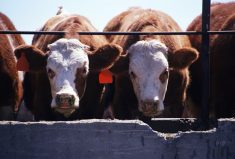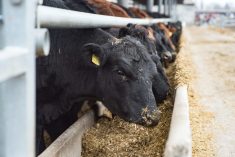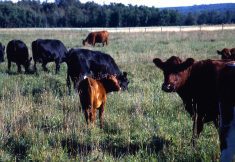A federal program backing research into farm-level technologies and practices that limit farms’ greenhouse gas (GHG) emissions has been picked up for another five-year run.
Agriculture Minister Lawrence MacAulay on Wednesday announced $27 million is budgeted over the 2016-21 period for the Agricultural Greenhouse Gases Program (AGGP).
More information about criteria for the renewed program is expected to be available by mid-April, the government said.
The 2011-16 AGGP put $21 million into 18 approved projects in seven provinces, out of 68 proposals submitted over those five years, the government said.
Read Also

Ample supplies and improved livestock sector to boost Canadian feed sector: FCC
Abundant feed grain supplies and improved profitability for the livestock sector should support strong feed demand and sales through the winter, says a new report from Farm Credit Canada.
The AGGP so far has backed research by universities, provincial governments, research institutions and conservation groups into GHG mitigation practices and technologies that can be adopted on the farm.
The previous program mapped out four “priority areas” for farm-level research, including livestock systems, cropping systems, water use efficiency and “agro-forestry.”
Best management practices (BMPs) studied during the previous AGGP included silvopasture — combinations of forestry and grazing in a single area — as well as manure injection systems, dairy cattle feeding strategies, anaerobic digesters, nutrient management and on-farm tools to assess and manage nitrogen emissions.
“We are communicating with participating farmers on what they are doing but we are also doing work on their fields. That has greater relevancy and authority to producers,” one unnamed researcher was quoted as saying in an evaluation the federal agriculture department ran last year on the AGGP.
“Too often, we are only doing research on research sites and on research plots which producers cannot relate to quite as directly as they can when they see the results in producers’ fields.”
Running such projects in farmers’ fields allows for “fewer controls” than in a research plot setting, the researcher said — “but we are undertaking these projects on producers’ fields to give these technologies exposure, and to engage these producers.”
Environment Minister Catherine McKenna, in Wednesday’s release, described the AGGP as “a great example of how research and technological progress can help address climate change. Reducing greenhouse gas emissions from farming will help support a more sustainable economy and build a greener future that will benefit all Canadians.”
“Faster progress”
Extending the AGGP funding also extends Canada’s commitment to the Global Research Alliance on Agricultural Greenhouse Gases, the government said Wednesday.
The stated aim of the alliance is to “deepen and broaden” mitigation research work across the cropland, livestock and paddy rice subsectors and the “cross-cutting” themes of soil carbon/nitrogen cycling and inventories/monitoring.
The group estimates agriculture today produces 14 per cent of the world’s annual GHG emissions and cites “recent predictions” which suggest a “dramatic increase” in food production will cause a 30-40 per cent rise in agricultural emissions from 2005 to 2050.
“Many countries already have research underway to better understand, measure and manage agricultural greenhouse gases emissions,” the organization says on its website.
“By linking up these efforts through the alliance, we can achieve faster progress towards the solutions needed for improving agricultural productivity and reducing its contribution to climate change.”
The alliance was founded in late 2009 and now has 46 member countries, among them the U.S., Mexico, China, Japan, Brazil, Argentina, Australia, New Zealand, Indonesia, the U.K., France and Germany. — AGCanada.com Network
















